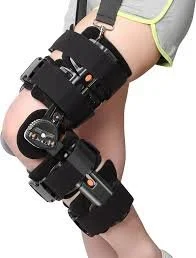D-Day for patient number 7
Patient #7: Signs of ACL Healing!
Could this be a turning point in ACL rehab?
If you’ve been following along, you’ll know we’ve been supporting “Patient Number 7” through the non-operative Cross Bracing Protocol for a torn ACL. Well—they are out of the brace and the 3-month MRI results are in...
And they’re showing signs of natural healing.
Yep, a torn ACL—long considered a one-way ticket to surgery—is showing continuity on MRI without surgery.
As physios, we’re quietly amazed (and a bit geekily excited). It’s one thing to read the emerging research, but another to see it working in real time with our own patient.
For patient number 7, it’s a huge milestone. For us, it’s a glimpse at what might be possible in the future of ACL rehab.
⏳ A Quick Recap: What’s the Cross Bracing Protocol?
When Patient 7 ruptured their ACL playing football, they had a bit of luck on their side and ticked all the right boxes to trial the non-operative Cross Bracing Protocol.
Here’s what it involves:
🔍 Early diagnosis (ideally within 7–10 days)
🦴 A clean ACL rupture confirmed via imaging
🦿 Brace locked at 90°, non-weight bearing for the first 4+ weeks
📈 Gradual progression in brace range over the next 8–12 weeks
🧪 3-month follow-up MRI to check for signs of natural healing
It’s not easy. Wearing a brace full-time—including sleeping in it—and limiting movement is a big commitment. But Patient 7 has been all-in, and it’s paying off.
✅ What the MRI Shows
Their 3/12 scan shows the torn ACL is reconnecting and healing!.
That doesn’t mean they're out of the woods—they still have a long rehab journey ahead—but it means surgery should not be necessary.
They have already been back doing gym work and progressing through a rehab plan focused on strength, stability, and confidence.
💡 Why Does This Matter?
If healing continues, Patient 7 should avoid surgery altogether. That could come with some major long-term benefits:
Less risk of developing osteoarthritis (OA)
Some studies suggest knees that avoid reconstruction may develop fewer joint changes over time—especially if there's no instability.Lower risk of re-rupture (in some cases)
Early research indicates that some native ACLs (if they heal) may outperform surgical grafts in durability.No graft = fewer complications
Avoiding hamstring or patellar tendon harvests means less post-op weakness or donor site pain.A personalised path
Rehab-first models give patients time to assess symptoms and response to treatment—rather than jumping straight to surgery.
⚖️ But Let’s Be Clear…
This isn’t an anti-surgery message.
ACL reconstruction still plays a vital role for many athletes—particularly those returning to high-level pivoting sports.
But what we’re seeing now is the start of a more flexible, evidence-informed conversation. In the right patient, with early imaging, commitment, and a structured protocol—healing may be possible.
📢 What’s Next?
We’ll keep closely monitoring Patient 7’s rehab and sharing updates—with their full permission. They've also kindly offered to write about their experience from the patient side, which we’ll feature in an upcoming newsletter.
If you or someone you know has torn their ACL, we’d love to help you weigh up your options. There’s more than one path forward—and we’re here to help you find the right one for your lifestyle and goals.

